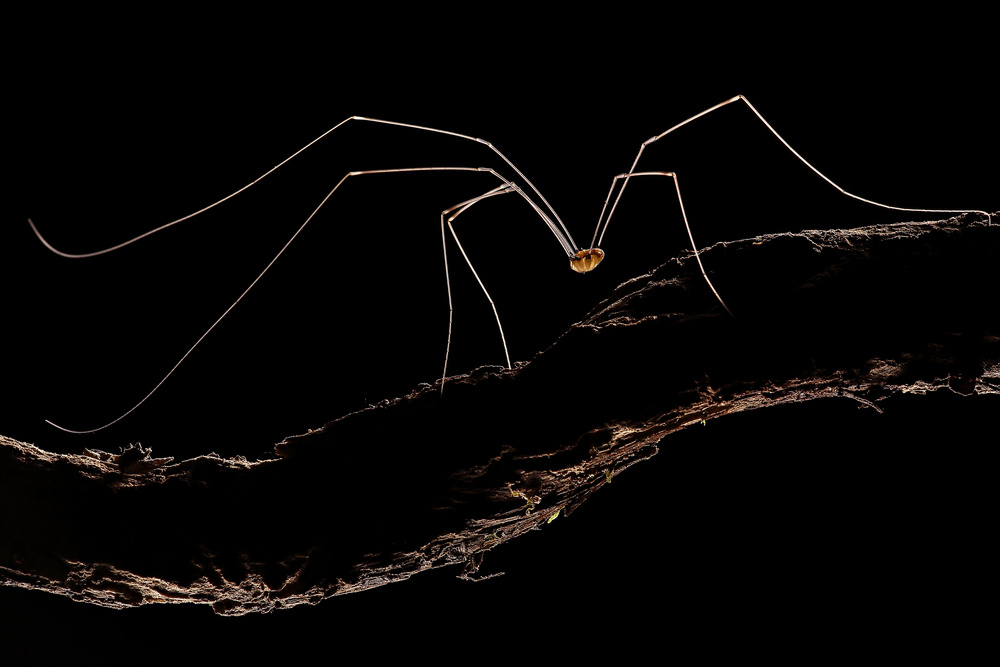SEARCH






|
|
|
|


by Editor Michel Romaggi in collaboration with the author Ruben Perez (fris)
Published the 4th of November 2020

'Legs like antennas' by Ruben Perez (fris)
This is a really strong picture, as for its documentary aspect and for the artistic treatment made by Ruben. It was a great idea using low key with the lightened spider getting out of the black background. The chosen angle makes the spider really looks very impressive. Congratulations, dear Ruben.
May we ask you how your took this unique macro shot?
You seem to handle well macro photography, Ruben. Why is it so appealing to you?
I don't spend that much time doing macro photography.
Most of the time it happened in the summer months – June, July and August - here in Spain.
During the rest of the year, I don't photograph a lot but enjoy nature photography.
Those images always learn me new things and the behaviour of different animals.
No matter how small they are, insects and arachnids tend to go unnoticed by most people and they do not realize the importance they have.
Regarding this picture precisely, in which circumstances did you meet this 'monster'?
Did your knowledge about it's lifestyle helped you to make shot?
That day, I left home with the idea of photographing dragonflies by a river not far from my house. Sometimes, in the morning, I regularly 'meet' this Opilion arachnid on branches near to the river bank. Always sitting there still and immobile. I knew these animals and already photographed them on other occasions.
However, till that very day, I was unaware of it's ability to use two of their legs as antennas. While photographing this one, I could perfectly perceive how a pair of legs was moving exactly as if they were antennas. I was so surprised by this behaviour that I decided to try to capture that ability in one of my images.
Later, when back home, I did a search on the internet for more information about I got home, I searched the internet for information about Opiliones, I read that indeed, they use their legs as sensors apart from other abilities such as voluntarily detaching themselves from one of their legs to avoid predators.
Technically speaking, how did you take this shot? Which camera, settings, light …?
The equipment used was a Canon 5D Mark III, with a lens 150 sigma macro lens, and a couple of flashes. The parameters were f/18, 1/200s, ISO250, manual focus, tripod.
Aesthetic research seems to have been as important as the documentary will, isn’t it?
Indeed, I always try to take maximum care of aesthetics in my images, especially composition and lighting. The photo is taken in the field, however, I almost set up a small studio. I tried to find a slightly dark background, shadow for example, which is as far as possible from the subject. Then it matters to close the diaphragm a lot so that natural light does not enter the sensor and to illuminate with artificial light. In this particular case I used two flashes with diffusers and warm gels, backlit more or less at 45º according to the subject to photograph.
How do you get that very special light in this picture as in a lot of your images.
Do you choose a special moment of the day, or do you get it during the post-process? Maybe both?
Specifically in this photo, the light is only and exclusively artificial created by two off-camera flashes with two diffusers and to give the scene that warm tone I placed two warm gels to the output of the flash modifying the tonality of its light. The flashes are placed to create a backlight, so solid objects such as the branch are only outlined, and translucent objects such as the legs are backlit.
On other occasions I use exclusively natural light, but that does not mean that the light does not have to be worked on through diffusers or reflectors, as in the following example:
And finally, many other times I work combining both lights, but always taking great care of aesthetics to combine them and that it is a little noticeable that there are two different types of lights. As in the following example:
'IF' you post-process your image, how do you proceed?
I don't like to post-process my photos, but obviously, when shooting in Raw, it is necessary. However, I try to work as much as possible at the moment of taking the photo and go home with almost finished images. Once downloaded I adjust - if necessary - levels and curves and finally apply an unsharp mask. That is my usual workflow. If I have to spend more than 10 minutes in processing a photo, I get tired so I prefer to spend an hour taking the photo and only 5 minutes processing it.
Finally, can you tell us about something more about you, how photography came into your life and what part it takes?
There is not much to tell about me, I am 43 years old, I am a father and I work as a naval mechanic. I started with photography as a hobby without much knowledge and little by little I trained myself mostly in a self-taught way. Over time, I succeeded to create my own style which is reflected in my work. I am very demanding about my photographs, perhaps a little too much in some occasions, but it is obvious that I have a limited knowledge of photography and I try to improve it whenever I can.
Many thanks for this most interesting interview, dear Ruben.
 | Write |
 | Yvette Depaepe CREW Thanks Ruben, for this extensive tutorial and congratulations. Great collaboration with Editor Michel Romaggi to present it to our readers. Cheers, Yvette |